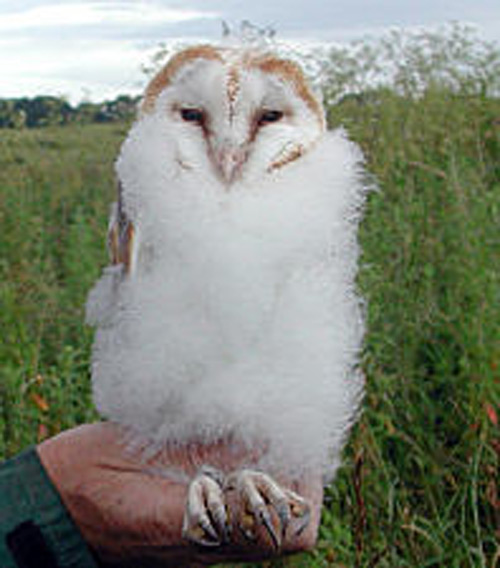









The Barn Owl (Tyto alba)
The Barn Owl can be identified by its distinctive white heart shaped face and white underparts. Its upper wings, back and tail are a pale golden buff, flecked with black, white and grey. In the north and east of Europe, a different subspecies Tyto alba guttata has a darker breast than the western and southern race Tyto alba alba which occurs in Britain.
Their characteristic "song" is a long eerie shriek though they are mostly silent outside of the breeding season. They also emit various purring, snoring and hissing noises - hissing is quite a common when the boxes are visited by the project.
The sexes can be told apart when in the hand as the females have a variable number of spots on the breast feathers whilst the male's breast is pure white. However, they are difficult to age accurately once the chicks have lost their down as they do not develop an immature plumage. Patterns of moult on the primary feathers can help.
Adult males weigh between 280-365g and the females weigh between 290-450g with the latter on average 50g heavier than males, though they have equal wing lengths.
Favoured hunting habitat is rough grassland which supports small mammals. They are normally nocturnal but sometimes hunt during the day in winter or when raising young. Perhaps this is more likely if the nights have been stormy as continuous rain prevents hunting and strong winds curtail it. Glue (1974) calculated that 97% of their prey is mammalian with voles constituting 50% of the total, shrews 32% and mice 14%. Birds, frogs, lizards and invertebrates are rarely taken.
Barn owls nest in holes in mature trees, barns and out-buildings and nowadays of course in specially made nest boxes. The first eggs are normally laid in April but it can be as early as February. The eggs are the dull white colour, typical of owls, but atypically, Barn Owl eggs are elliptical. The clutch size is very variable, usually 4-7, occasionally 2-13. Even bigger clutches have been known from Germany but it's possible that the bigger clutches involve two females laying in the same nest. Bigger clutches (and the incidence of second broods) correlate with the abundance of prey. The largest clutch that RuBOP has found was 9 from a box at Bingham in 2014 and this went on to produce the biggest successful brood of 7 then, later the same day, another brood of 7 was found! The final chick of the latter brood was the 900th to be ringed since the project began.
During incubation, which normally begins when the first egg is laid, the female rarely leaves the nest and depends on the male to bring her food. Subsequent eggs are laid at intervals of 2.5 days on average so a hatched brood will be a mix of ages and this is glaringly apparent when the chicks are removed for ringing. Fortunately the legs are almost full size from the outset and birds can be ringed when they are quite young. If food become scarce, the strongest birds get first servings and the smallest birds will die. This ensures that at least some of the young have a chance to fledge. They leave the nest when they are between 7 and 8 weeks old and for a few weeks they are helped by the parents but by 11 weeks old they either leave or are driven out of the territory. Three out of every four dies on average during their first winter. Maximum life expectancy in the wild is around five years (though in captivity and when well cared for they can live over twenty years). They will breed when they are one-year old and they pair for life if conditions remain optimal.
Before RuBOP and other similar projects began, the Barn Owl had declined by 50% in the UK in the previous 50 years. This decline was attributed to a combination of the following factors:
- Loss of feeding habitat.
- Loss of nesting sites.
- Poisons used in the control of rats and mice.
- Drowning.
- Road traffic accidents.
The species is now believed to have recovered to its former numbers thanks to projects like RuBOP and there are now well over 100 pairs using boxes in Nottinghamshire in most years.
 RW
RW